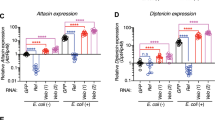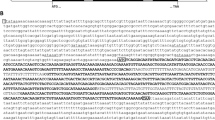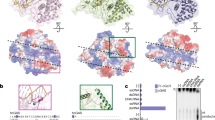Abstract
Microbial infection activates two distinct intracellular signalling cascades in the immune-responsive fat body of Drosophila1,2. Gram-positive bacteria and fungi predominantly induce the Toll signalling pathway, whereas Gram-negative bacteria activate the Imd pathway3,4. Loss-of-function mutants in either pathway reduce the resistance to corresponding infections4,5. Genetic screens have identified a range of genes involved in these intracellular signalling cascades6,7,8,9,10,11,12, but how they are activated by microbial infection is largely unknown. Activation of the transmembrane receptor Toll requires a proteolytically cleaved form of an extracellular cytokine-like polypeptide, Spätzle13, suggesting that Toll does not itself function as a bona fide recognition receptor of microbial patterns. This is in apparent contrast with the mammalian Toll-like receptors14 and raises the question of which host molecules actually recognize microbial patterns to activate Toll through Spätzle. Here we present a mutation that blocks Toll activation by Gram-positive bacteria and significantly decreases resistance to this type of infection. The mutation semmelweis (seml) inactivates the gene encoding a peptidoglycan recognition protein (PGRP-SA). Interestingly, seml does not affect Toll activation by fungal infection, indicating the existence of a distinct recognition system for fungi to activate the Toll pathway.
This is a preview of subscription content, access via your institution
Access options
Subscribe to this journal
Receive 51 print issues and online access
$199.00 per year
only $3.90 per issue
Buy this article
- Purchase on Springer Link
- Instant access to full article PDF
Prices may be subject to local taxes which are calculated during checkout




Similar content being viewed by others
References
Hoffmann, J. A., Kafatos, F. C., Janeway, C. A. & Ezekowitz, R. A. Phylogenetic perspectives in innate immunity. Science 284, 1313–1318 (1999).
Khush, R. S., Leulier, F. & Lemaitre, B. Drosophila immunity: two paths to NF-κB. Trends Immunol. 22, 260–264 (2001).
Lemaitre, B., Reichhart, J. M. & Hoffmann, J. A. Drosophila host defense: differential induction of antimicrobial peptide genes after infection by various classes of microorganisms. Proc. Natl Acad. Sci. USA 94, 14614–14619 (1997).
Lemaitre, B. et al. A recessive mutation, immune deficiency (imd), defines two distinct control pathways in the Drosophila host defense. Proc. Natl Acad. Sci. USA 92, 9465–9469 (1995).
Lemaitre, B., Nicolas, E., Michaut, L., Reichhart, J. M. & Hoffmann, J. A. The dorsoventral regulatory gene cassette spatzle/Toll/cactus controls the potent antifungal response in Drosophila adults. Cell 86, 973–983 (1996).
Rutschmann, S. et al. The Rel protein DIF mediates the antifungal but not the antibacterial host defense in Drosophila. Immunity 12, 569–580 (2000).
Leulier, F., Rodriguez, A., Khush, R. S., Abrams, J. M. & Lemaitre, B. The Drosophila caspase Dredd is required to resist Gram-negative bacterial infection. EMBO Rep. 1, 353–358 (2000).
Rutschmann, S. et al. Role of Drosophila IKKγ in a Toll-independent antibacterial immune response. Nature Immunol. 1, 342–347 (2000).
Lu, Y., Wu, L. P. & Anderson, K. V. The antibacterial arm of the Drosophila innate immune response requires an IκB kinase. Genes Dev. 15, 104–110 (2001).
Vidal, S. et al. Mutations in the Drosophila dTAK1 gene reveal a conserved function for MAPKKKs in the control of rel/NF-κB-dependent innate immune responses. Genes Dev. 15, 1900–1912 (2001).
Meng, X., Khanuja, B. S. & Ip, Y. T. Toll receptor-mediated Drosophila immune response requires Dif, an NF-κB factor. Genes Dev. 13, 792–797 (1999).
Hedengren, M. et al. Relish, a central factor in the control of humoral but not cellular immunity in Drosophila. Mol. Cell 4, 827–837 (1999).
Levashina, E. A. et al. Constitutive activation of Toll-mediated antifungal defense in serpin-deficient Drosophila. Science 285, 1917–1919 (1999).
Akira, S., Takeda, K. & Kaisho, T. Toll-like receptors: critical proteins linking innate and acquired immunity. Nature Immunol. 2, 675–680 (2001).
Celine, L. F. Semmelweis. L’imaginaire (Gallimard, Paris, 1999).
Belvin, M. P. & Anderson, K. V. A conserved signaling pathway: the Drosophila Toll-dorsal pathway. Annu. Rev. Cell Dev. Biol. 12, 393–416 (1996).
Kang, D., Liu, G., Lundström, A., Gelius, E. & Steiner, H. A peptidoglycan recognition protein in innate immunity conserved from insects to humans. Proc. Natl Acad. Sci. USA 95, 10078–10082 (1998).
Werner, T. et al. A family of peptidoglycan recognition proteins in the fruit fly Drosophila melanogaster. Proc. Natl Acad. Sci. USA 97, 13772–13777 (2000).
Liu, C., Gelius, E., Liu, G., Steiner, H. & Dziarski, R. Mammalian peptidoglycan recognition protein binds peptidoglycan with high affinity, is expressed in neutrophils, and inhibits bacterial growth. J. Biol. Chem. 275, 24490–24499 (2000).
Janeway, C. A. Jr Approaching the asymptote? Evolution and revolution in immunology. Cold Spring Harb. Symp. Quant. Biol. 54, 1–13 (1989).
Poltorak, A. et al. Defective LPS signaling in C3H/HeJ and C57BL/10ScCr mice: mutations in Tlr4 gene. Science 282, 2085–2088 (1998).
Poltorak, A., Ricciardi-Castagnoli, P., Citterio, S. & Beutler, B. Physical contact between lipopolysaccharide and Toll-like receptor 4 revealed by genetic complementation. Proc. Natl Acad. Sci. USA 97, 2163–2167 (2000).
Takeuchi, O. et al. Differential roles of TLR2 and TLR4 in recognition of Gram-negative and Gram-positive bacterial cell wall components. Immunity 11, 443–451 (1999).
Hemmi, H. et al. A Toll-like receptor recognizes bacterial DNA. Nature 408, 740–745 (2000).
Hayashi, F. et al. The innate immune response to bacterial flagellin is mediated by Toll-like receptor 5. Nature 410, 1099–1103 (2001).
Ozinsky, A. et al. The repertoire for pattern recognition of pathogens by the innate immune system is defined by cooperation between Toll-like receptors. Proc. Natl Acad. Sci. USA 97, 13766–13771 (2000).
Medzhitov, R., Preston-Hurlburt, P. & Janeway, C. A. Jr A human homologue of the Drosophila Toll protein signals activation of adaptive immunity. Nature 388, 394–397 (1997).
Tauszig, S., Jouanguy, E., Hoffmann, J. A. & Imler, J. L. Toll-related receptors and the control of antimicrobial peptide expression in Drosophila. Proc. Natl Acad. Sci. USA 97, 10520–10525 (2000).
Franc, N. C. & White, K. Innate recognition systems in insect immunity and development: new approaches in Drosophila. Microbes Infect. 2, 243–250 (2000).
Turner, M. W. & Hamwas, R. M. Mannose-binding lectin: structure, function, genetics and diseases associations. Rev. Immunogenet. 2, 305–322 (2000).
Acknowledgements
We thank our colleagues for comments on the manuscript, M. E. Moritz and M. Schneider for providing bacterial and fungal cultures, and C. Chevalier for sequencing. This work was supported by CNRS, the Ministère de l’Education Nationale de la Recherche et de la Technologie, and the Fondation pour la Recherche Médicale (Implantation jeunes équipes to J.R.). Financial support from Entomed, Exelixis and the National Institutes of Health is acknowledged.
Author information
Authors and Affiliations
Corresponding author
Ethics declarations
Competing interests
The authors declare no competing financial interests.
Rights and permissions
About this article
Cite this article
Michel, T., Reichhart, JM., Hoffmann, J. et al. Drosophila Toll is activated by Gram-positive bacteria through a circulating peptidoglycan recognition protein. Nature 414, 756–759 (2001). https://doi.org/10.1038/414756a
Received:
Accepted:
Issue Date:
DOI: https://doi.org/10.1038/414756a
This article is cited by
-
Effects of TmTak1 silencing on AMP production as an Imd pathway component in Tenebrio molitor
Scientific Reports (2023)
-
Characterization of PGRP-LB and immune deficiency in the white-backed planthopper Sogatella furcifera (Hemiptera: Delphacidae)
Applied Entomology and Zoology (2022)
-
Identification, Phylogeny and Expressional Profiles of Peptidoglycan Recognition Protein (PGRP) Gene Family in Sinonovacula constricta
Journal of Ocean University of China (2022)
-
Sensing microbial infections in the Drosophila melanogaster genetic model organism
Immunogenetics (2022)
-
Transgenic Silkworms Overexpressing Relish and Expressing Drosomycin Confer Enhanced Immunity to Multiple Pathogens
Molecular Biotechnology (2022)
Comments
By submitting a comment you agree to abide by our Terms and Community Guidelines. If you find something abusive or that does not comply with our terms or guidelines please flag it as inappropriate.



